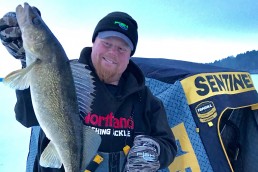Early-ice Walleye Binge
SHARE THIS POST
Brian Brosdahl knows early ice is often the best time of the winter for walleye fishing.
Ice safety is key, and there is plenty of good ice safety advice on the web. The main idea is to know what you are doing, and always err on the side of safety. Anglers are responsible for themselves, with the main goal of having a safe trip.
Once the ice is ready and anglers are able to get on the lakes, shoreline structure usually gets all the fishing pressure early in the season. I am always looking for good areas to fish from my boat in the fall, so I can come back early in the ice fishing season.
I want locations that are within easy walking distance from an access point, and I am looking for areas with features I think will attract fish on early ice.
Fishing usually starts out good as soon as anglers can get on the ice, and keeps getting better as anglers are able to access more areas on the lakes. In northern Minnesota, the peak fishing usually happens in late December or early January, before the coldest part of the winter arrives.
The winter walleye bite starts out along the shoreline break, and moves further from shore as the season progresses. Some anglers walk out early, but quickly switch to ATVs and snowmobiles as the ice conditions improve.
Anglers don’t usually have a lot of choices for structure early in the season. Turns or points along the shoreline break are usually it. Anglers can look for structural elements like green weeds, boulders, gravel, hard bottom areas or even just stretches with a steeper break leading into deep water.
Walleyes often follow edges when they get active and feed. If anglers can position themselves in the right area, walleyes will often move through their location when they get active. Sometimes will go through the same area on their way in and out of structure as they feed.
The peak bite is usually earlier in the afternoon and mornings on stained lakes, but in lakes with clear water, the peak bite is usually at dawn or dusk and after dark.
Are you enjoying this post?
You can be among the first to get the latest info on where to go, what to use and how to use it!
Once anglers find an area the fish are using, then it is a matter of breaking down the area to find the best location to put a portable fish house.
I have GPS icons I placed during open water that give me a starting point on structures. I usually drill some holes up and down the break to try locating the fish. I use the mapping feature on my Humminbird Helix 7 Ice, so it adds data to my map every time I drop the transducer down a new hole.
I use my AquaVu while I fish to check out what is happening below the ice. I use the Frabill Sentinel when I search for spots on foot, so I can haul all my gear in the fish house.
Anglers are looking for high-percentage areas where the fish are more likely to pass through when they are actively feeding. On shallow lakes like Upper Red Lake, the best structure is often just a slight turn on the breakline, a patch of gravel and rocks or a section of the breakline that drops quicker than the rest of the breakline.
Walleyes like to follow the base of the drop along the breakline, until they run into a school of baitfish. They often make feeding runs when they get active, and will continue to use the same areas until the food source is depleted, or fishing pressure moves them out of the area.
Anglers seeing schools of baitfish on sonar, but not catching any walleyes, may be in the right area at the wrong time. It is very rare for a concentration of baitfish not to attract some predator fish. It might not be happening every time you check the area, but it usually pays to come back later if you don’t want to sit there and wait them out.
First ice happens from the moment anglers can get on the ice until the cold weather and snow slows down the bite. Enjoy it while it lasts; it’s a long winter.
Learn where and when to catch the most fish through the ice this winter. Read the December issue of MidWest Outdoors, available the first full week of December at the newsstand or by subscribing on our website.
MWO
SHARE THIS POST
You may also like...
Nothing found.
Did you enjoy this post?
You can be among the first to get the latest info on where to go, what to use and how to use it!
Brian 'Bro' Brosdahl
Outdoor communicator Brian “Bro” Brosdahl lives in northern Minnesota. He is a walleye guide in the Cass Lake, Leech Lake and Lake Winnibigoshish areas. He is sponsored by Northland Fishing Tackle, Frabill/Plano, Aqua-Vu, Humminbird/Minn Kota, St. Croix Rods, Ranger Boats, and Evinrude. Guide inquiries: brosguideservice.com. Follow on social media.
